Trash to Treasure: Creating Your Dream Flea Market Garden
Have you ever wandered through a flea market on a Saturday morning, that perfect cup of coffee warming your hands, when you spot it? That one thing that makes your heart skip a beat—a rusted metal chair with intricate scrollwork, a chipped porcelain sink, or maybe a set of mismatched galvanized buckets. And in that moment, you don’t just see an old object. You see a planter, a fountain, a container garden. You see possibility. That’s the magic of flea market gardens, and honestly, once you catch the bug, there’s no going back.
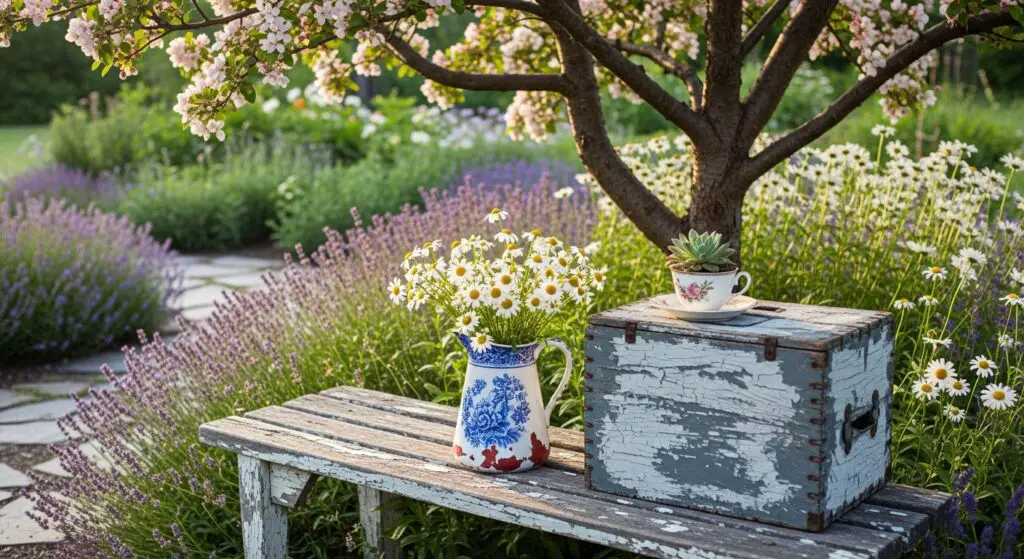
The Allure of Flea Market Gardens
There’s something incredibly special about flea market gardens that you just can’t replicate with brand-new, perfectly coordinated garden center purchases. Maybe it’s the history embedded in every weathered surface, or the satisfaction of giving new life to something discarded. Or perhaps it’s the way these vintage pieces seem to belong in the garden, as if they’ve been there all along, slowly becoming part of the landscape.
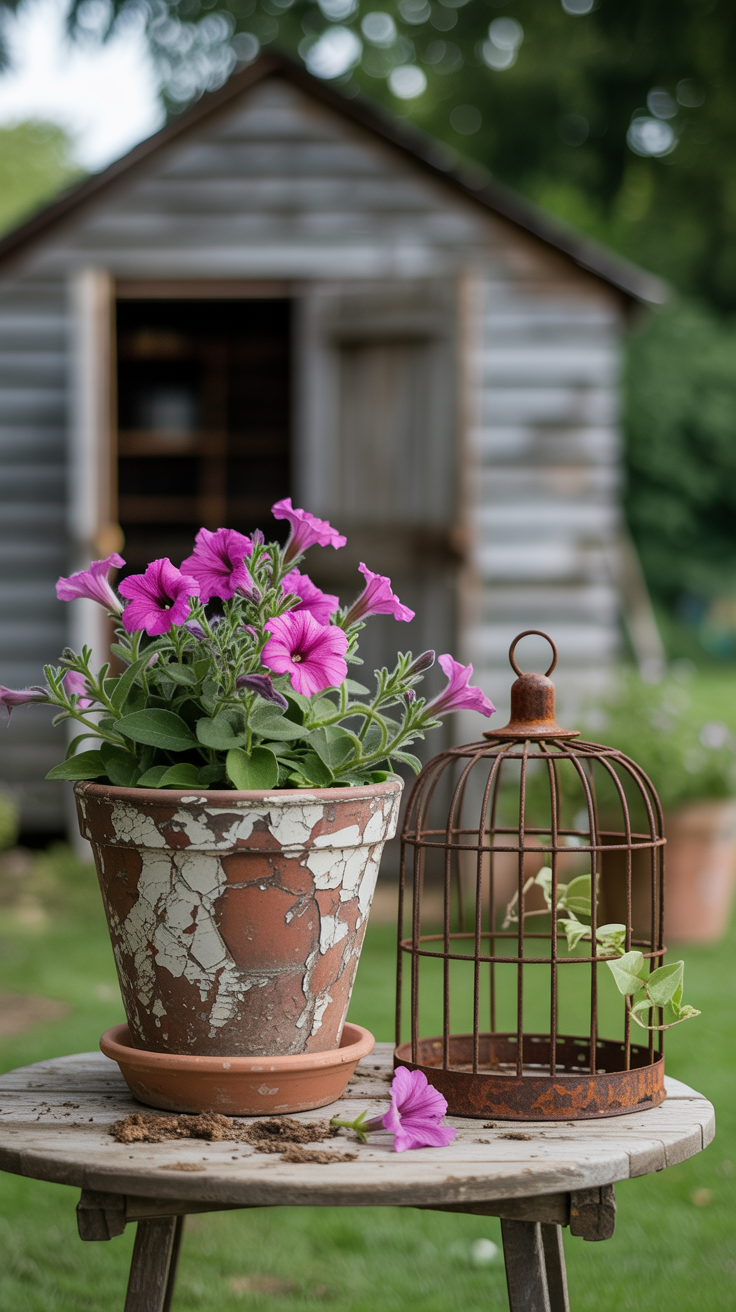
I think what draws us to flea market gardening is the perfect imperfection of it all. You know that moment when you place a slightly chipped ceramic pot filled with cascading petunias on a weathered wooden bench, and somehow it looks more beautiful than anything you could have planned? That’s the sweet spot we’re chasing.
When I first started creating flea market garden vignettes in my own backyard, I was worried about getting it “right.” But here’s what I’ve learned: there is no right. There’s only what makes you smile when you look out your window. There’s only what makes your guests pause and say, “Now that’s clever.”
Finding Your Flea Market Garden Style
The beauty of flea market garden style is that it can be whatever you want it to be. Unlike rigid design trends, this approach to gardening is deeply personal and endlessly adaptable. But if you’re just starting out, it helps to identify a general direction that resonates with you.
Rustic Farmhouse Vibes
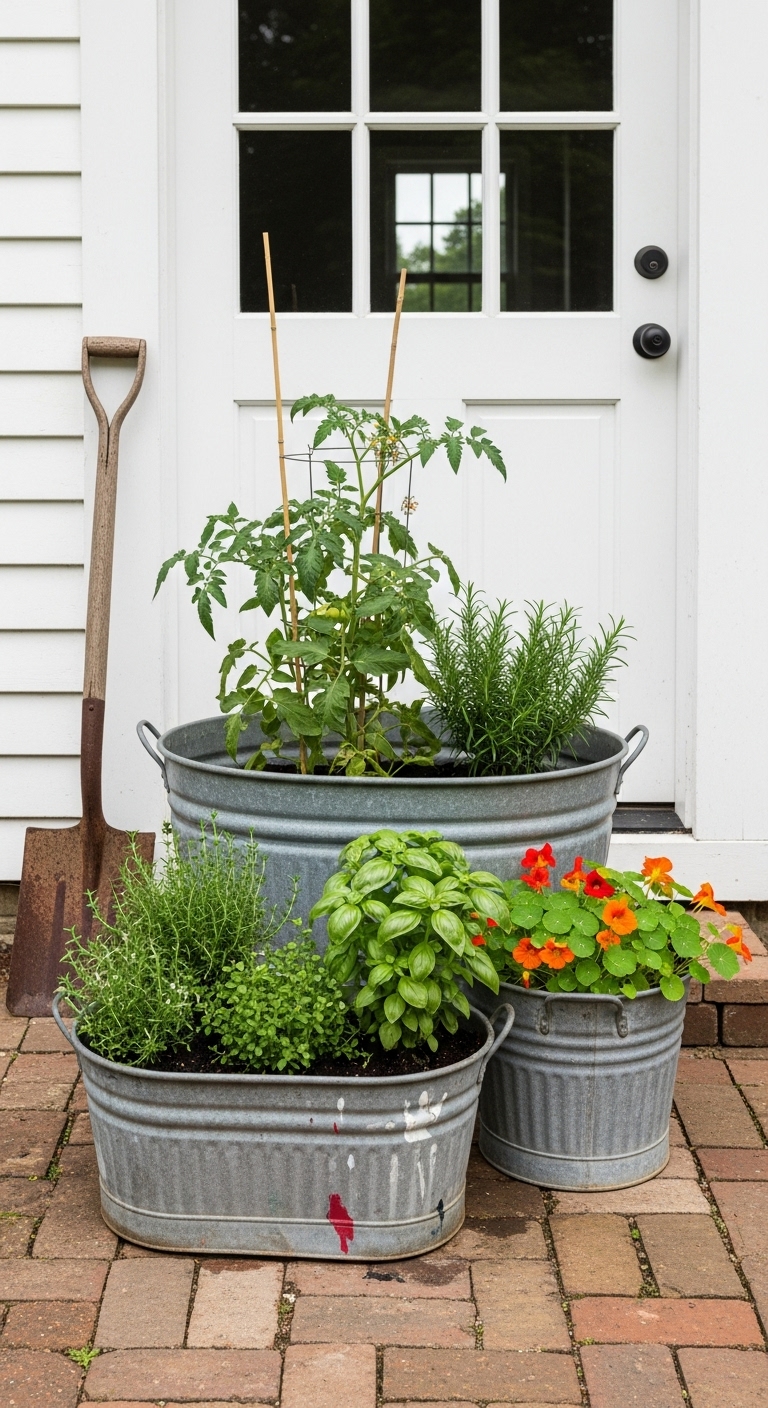
If you love the idea of a garden that looks like it’s been there for generations, you might lean toward a rustic farmhouse approach. Think galvanized watering cans overflowing with herbs, weathered wooden crates repurposed as raised beds, and old milk jugs transformed into charming watering stations.
The key to this style is embracing the natural aging process. Don’t worry about a little rust or peeling paint—those are the details that tell a story. I once found an old wooden ladder with chipped white paint at a flea market for just $15. Leaned against my garden shed with terra cotta pots on each rung, it became the focal point of my entire vegetable garden.
Eclectic Collector’s Paradise
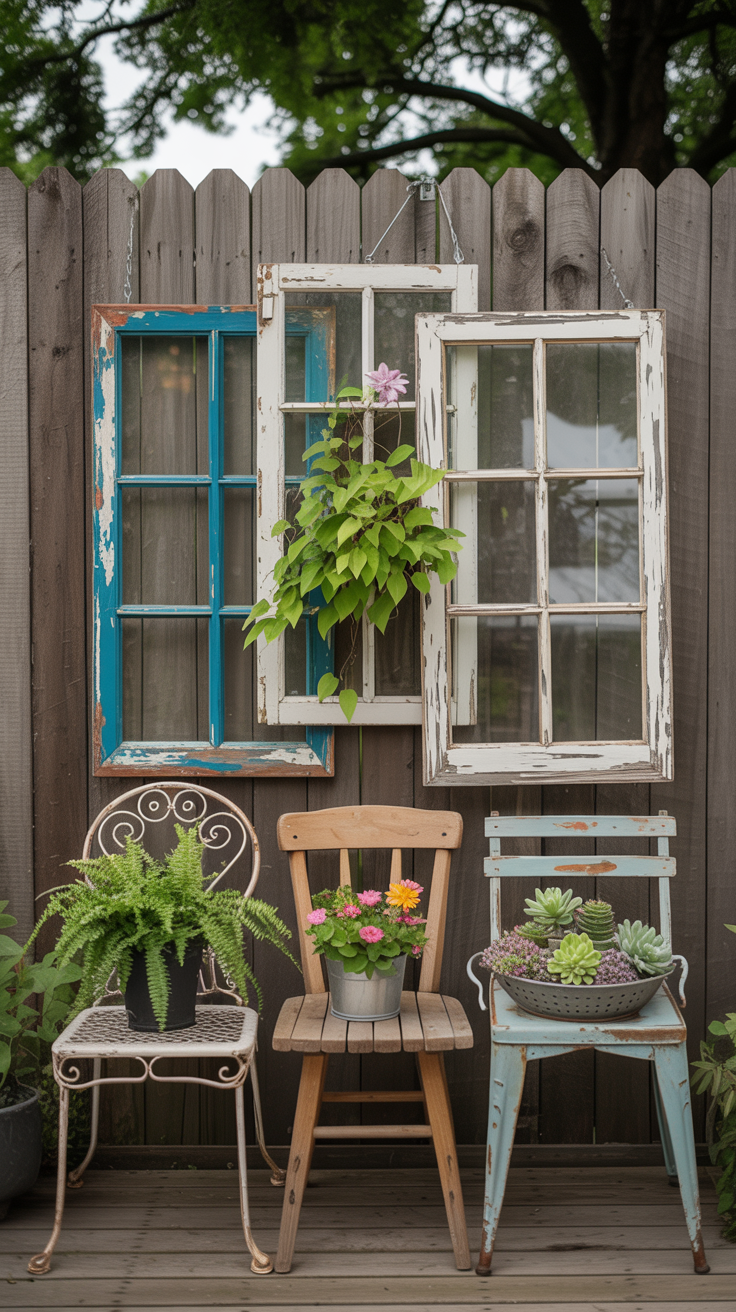
Maybe you’re the type who can’t resist bringing home unique finds, even if they don’t match anything else you own. Welcome to the eclectic collector’s approach to flea market gardening! This style is all about mixing metals, eras, and textures to create something entirely unique.
The secret here is finding a unifying element. It might be a consistent color palette (I’m partial to the combination of weathered turquoise and rusty orange), or perhaps repeating certain shapes throughout your garden. One of my favorite flea market garden ideas is to use vintage window frames as “walls” for climbing plants. When you hang several different styles together, they create a stunning backdrop that somehow works despite the differences.
Minimalist Vintage Appeal
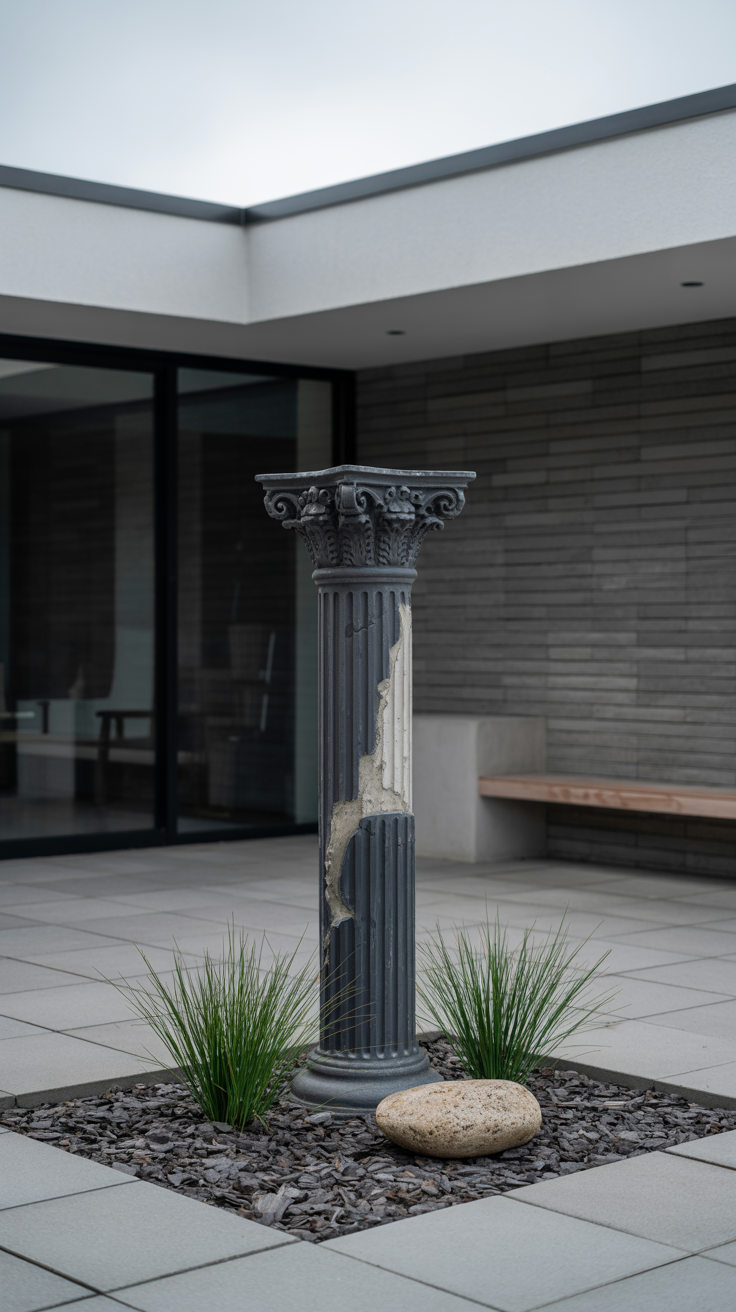
For those who prefer a cleaner aesthetic, minimalist vintage flea market gardening might be your sweet spot. This doesn’t mean sterile or boring—rather, it’s about selecting just a few statement pieces that really shine.
A single architectural salvage piece, like an old column or a decorative iron gate section, can serve as a dramatic focal point. Pair it with simple plantings and let the vintage item take center stage. Less really can be more when you’re working with pieces that have this much character.
The Hunt: Sourcing Flea Market Garden Treasures
Now for the fun part—the hunt! There’s nothing quite like the thrill of discovering the perfect piece for your flea market garden. But successful flea market gardening requires a bit of strategy.

Timing Is Everything
Early birds really do get the worms at flea markets. I’m talking 6 AM early, coffee in hand, flashlight optional (but sometimes necessary). The best vintage flea market gardening pieces tend to go quickly, so arriving early gives you first dibs.
That said, there’s something to be said for the late-afternoon approach. Sellers are often more willing to negotiate prices as they’re thinking about packing up, and you might score a deal on something they’d rather not haul home. I once got a beautiful set of wrought iron plant stands for half the original price simply by showing up an hour before closing.
What to Look For
When you’re hunting for flea market garden decor, it helps to look beyond an item’s original purpose. That old wooden toolbox? Perfect tiered herb garden. Those mismatched teacups? Adorable succulent planters. A rusty bicycle wheel? Instant trellis for climbing vines.
I always keep an eye out for:
- Containers with drainage holes (or the potential to add them)
- Items with interesting textures or patinas
- Pieces made from materials that can withstand outdoor conditions
- Objects with multiple levels or compartments for planting variety
Building Relationships
Here’s a tip that took me way too long to figure out: get to know the vendors. Regular flea market sellers are often collectors themselves, and they might just keep an eye out for specific pieces if they know what you’re looking for.
I’ve become friendly with a gentleman who specializes in architectural salvage. Last month, he set aside a beautiful iron gate section for me before he even brought it to the market. These relationships can transform your flea market gardening from hit-or-miss to a curated collection that tells your story.
Upcycled Garden Treasures: Transformation Techniques

Once you start accumulating flea market finds, you’ll need to transform them into functional garden elements. This is where your creativity really gets to shine!
Preparing Your Finds
Before you start any transformation, give your treasures a good cleaning. I’m not talking about stripping away all the character—just removing dirt, loose paint, and any elements that might harm your plants.
For metal pieces, a wire brush followed by a coat of clear exterior sealant can help prevent further rusting while preserving that beautiful patina. Wooden items might benefit from a sanding to remove splinters, followed by an exterior wood sealant.
Creating Planters
Converting flea market finds into planters is perhaps the most common transformation in flea market gardening. The key is ensuring proper drainage.
For items that can’t be drilled (like porcelain or ceramic), consider the “double pot” method: place a plastic pot with drainage holes inside your vintage container. This protects both the vintage piece and your plants’ roots.
I once turned an old metal mailbox into a stunning vertical herb garden. By drilling holes in the bottom for drainage and mounting it on a fence post, I created a space-saving herb garden that gets compliments from everyone who visits.
Building Structures
Some of the most impressive flea market garden ideas involve creating structures. Old ladders become vertical gardens, bed frames transform into arbors, and windows create magical garden “walls.”
My favorite project to date was using three mismatched shutters hinged together to create a privacy screen for my patio. I added hooks for hanging baskets and small shelves for potted herbs. It provides just the right amount of separation from my neighbors while serving as a living wall of plants.
Designing Flea Market Garden Vignettes
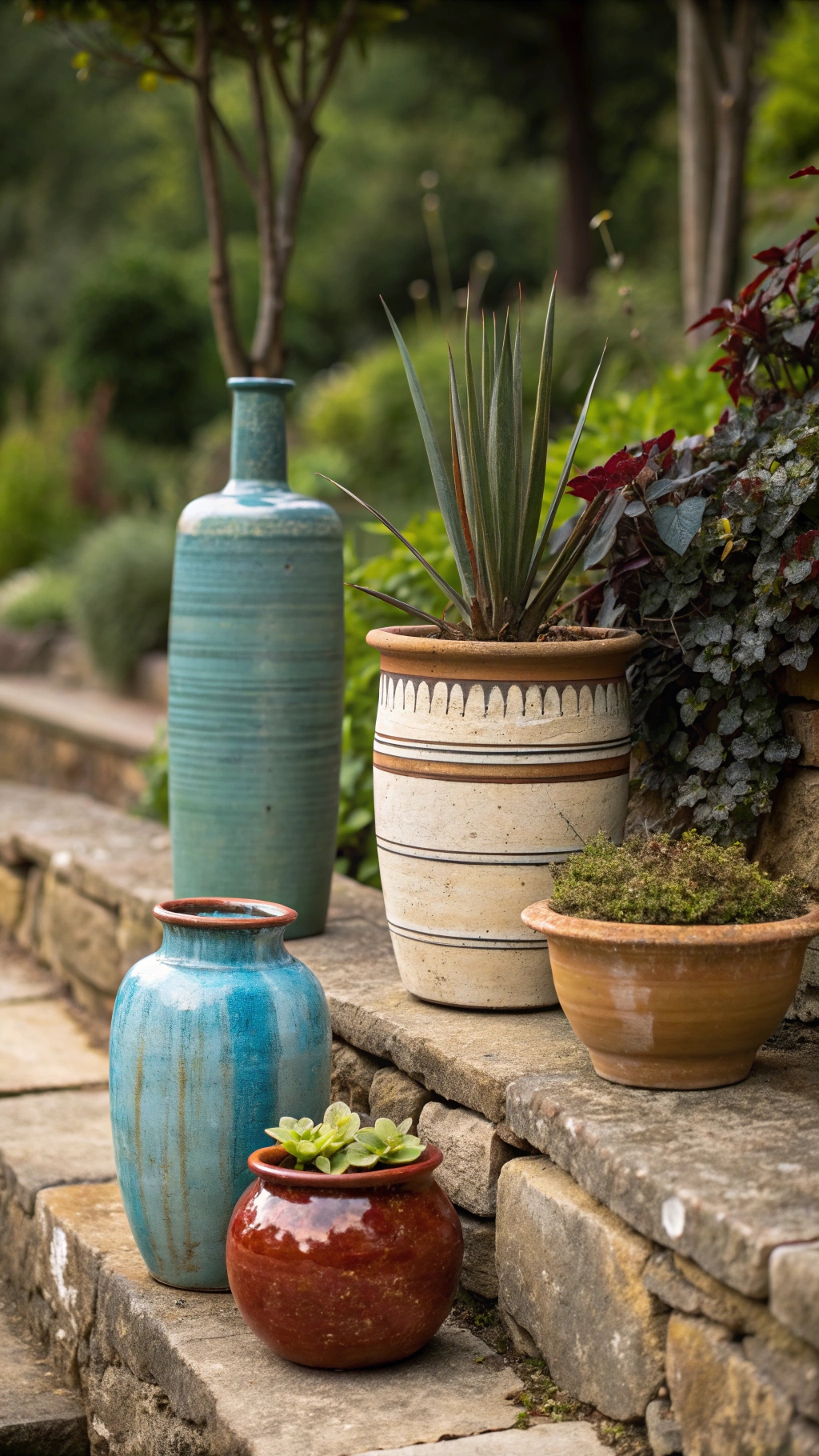
Creating effective flea market garden vignettes is about more than just placing objects in your garden. It’s about telling a story and creating moments of discovery.
The Rule of Three
I’m not usually one for rigid design rules, but the rule of three really works in flea market gardens. Grouping items in odd numbers creates visual interest and feels more natural than even-numbered groupings.
Try placing three different sized pots together, or three vintage garden tools arranged on a fence. This principle applies to plants as well—three different textures or heights create more dynamic compositions than single varieties.
Creating Focal Points
Every garden needs a focal point, and flea market finds are perfect for this role. Whether it’s a vintage birdbath, an ornate mirror reflecting your plantings, or a collection of colorful bottles “planted” among your flowers, these elements draw the eye and give your garden structure.
My garden’s focal point is an old church pew I found for $30. Painted a cheerful turquoise and positioned under a climbing rose, it invites visitors to sit and stay awhile. It’s not just furniture—it’s an invitation to experience the garden more fully.
Incorporating Movement
Static elements are beautiful, but gardens that incorporate movement feel more alive. Vintage wind chimes, hanging elements that catch the breeze, or even mobiles made from old silverware can add that extra dimension that makes your flea market garden truly special.
I created a simple mobile using old silver spoons and forks that I bent and attached to a driftwood branch. The way they catch the light and create soft music in the breeze adds another sensory layer to the garden experience.
Flea Market Garden Ideas for Backyards of All Sizes
Whether you have a sprawling suburban lot or a tiny urban balcony, flea market gardening can work for you. It’s all about scaling the concept to fit your space.
Small Space Solutions
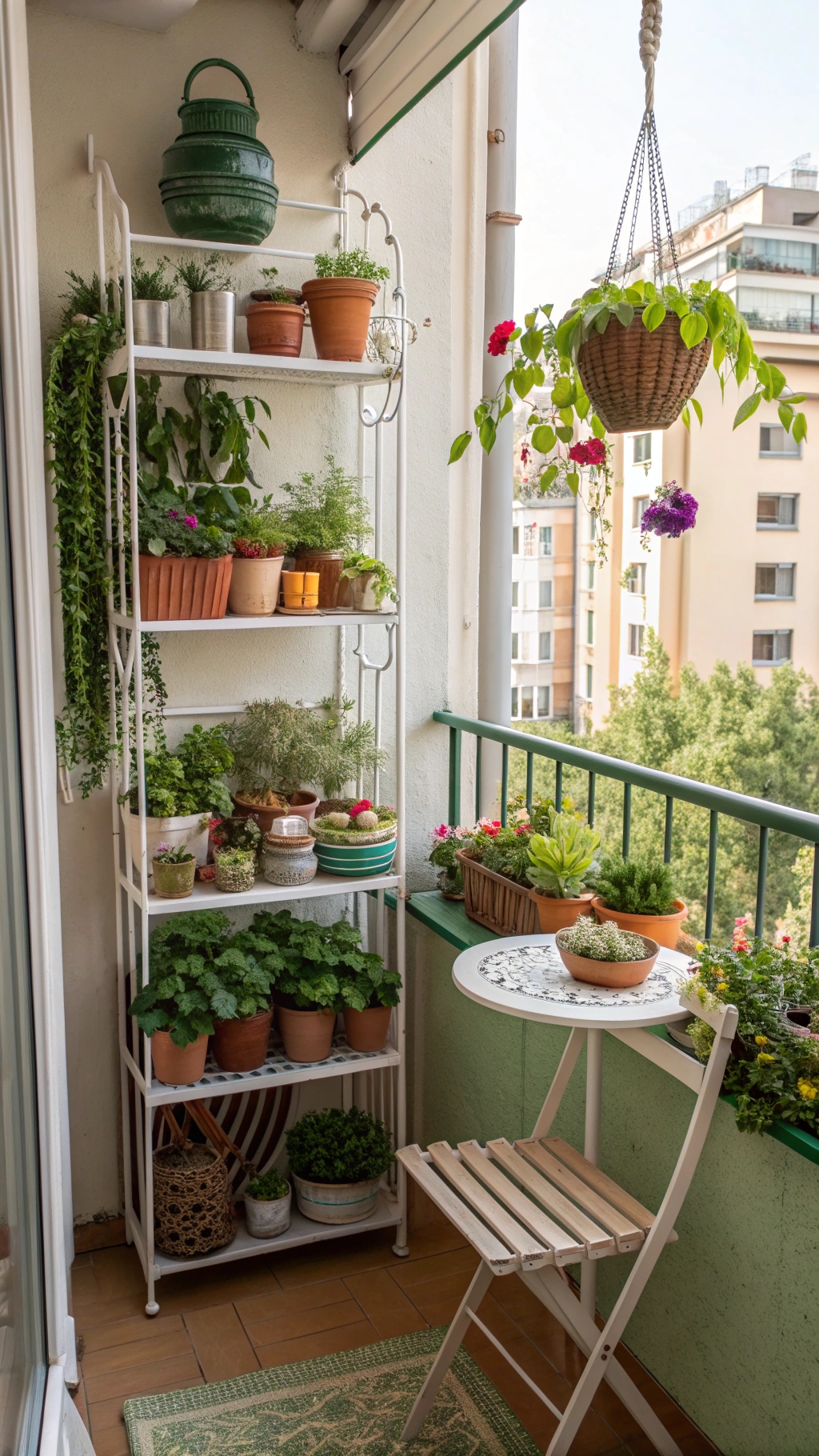
For those working with limited space, vertical flea market garden ideas are your best friend. Old wooden pallets can be transformed into living walls, vintage ladders provide tiered growing space, and hanging baskets made from colanders or old kitchen strainers add charm without taking up ground space.
My apartment-dwelling sister created an incredible balcony garden using a vintage baker’s rack as her foundation. Each shelf holds different containers, from old teapots to enamelware bowls, creating a lush oasis in just a few square feet.
Large Yard Possibilities
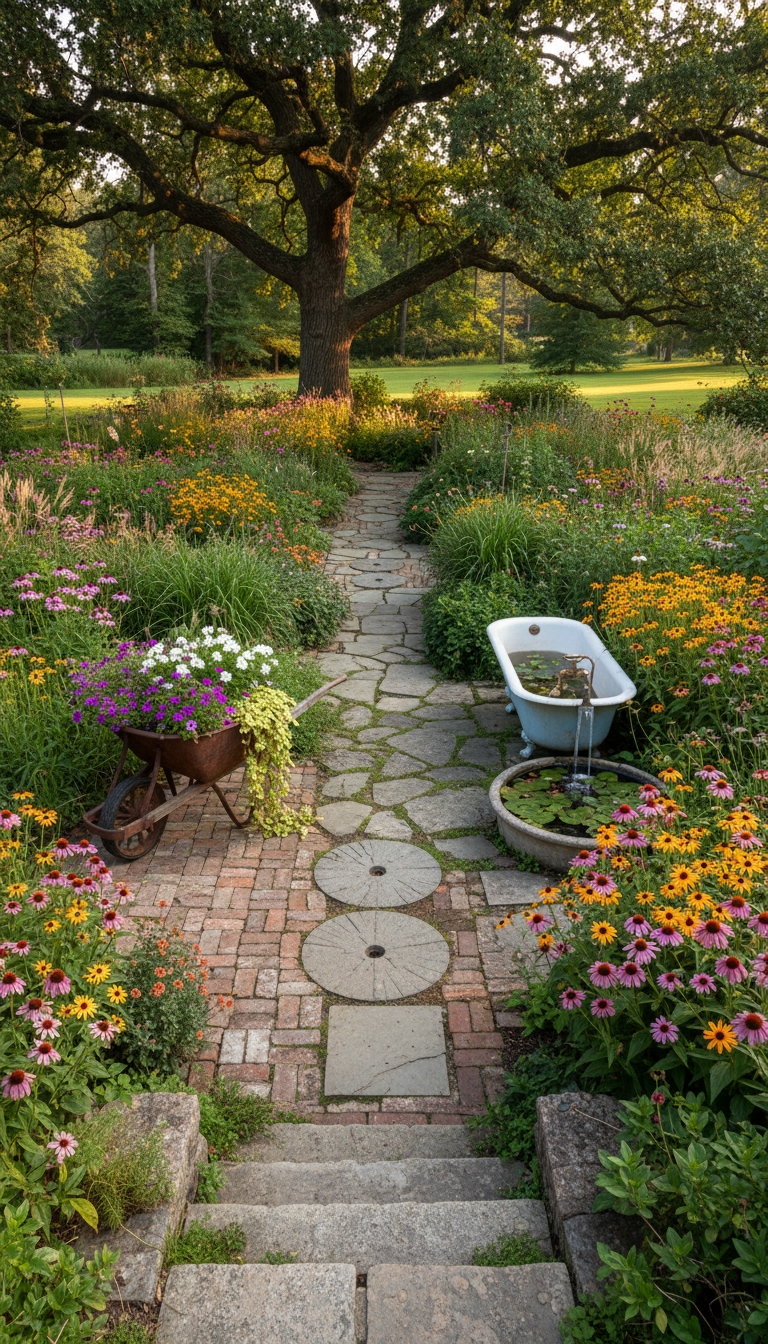
If you’re blessed with more space, you can really go wild with flea market garden ideas. Consider creating distinct “rooms” in your garden, each with its own vintage theme. A dining area with mismatched vintage chairs and tables, a meditation corner with an old church pew and weathered statues, or a potting station arranged from antique cabinets and sinks.
One of my most ambitious projects was creating a “flea market garden path” using old stepping stones I collected over time, each with its own story. Some were from demolished buildings, others were cast-offs from neighbors, and a few were actual flea market finds. The path doesn’t just lead through my garden—it tells its story.
Vintage Flea Market Gardening Through the Seasons
A well-designed flea market garden looks beautiful in every season. With a little planning, your vintage treasures can shine year-round.
Spring Awakening
Spring is the perfect time to refresh your flea market garden displays. As you’re planting, consider how your vintage pieces will work with emerging bulbs and early bloomers. I love placing vintage egg baskets filled with pansies or forcing bulbs in old teacups for early spring color.
This is also the time to assess any winter damage to your outdoor pieces. A fresh coat of paint or sealant can extend the life of your flea market finds for another season.
Summer Abundance
Summer is when flea market gardens really come into their own. Overflowing containers, lush growth, and abundant flowers create the perfect backdrop for your vintage treasures. This is when those old washtubs filled with colorful annuals or vintage bicycles adorned with hanging baskets really shine.
During the hottest months, consider how your vintage pieces can provide support to your plants. Old trellises, gates, or even bed frames can give climbing plants the structure they need to reach their full potential.
Autumn’s Rich Palette
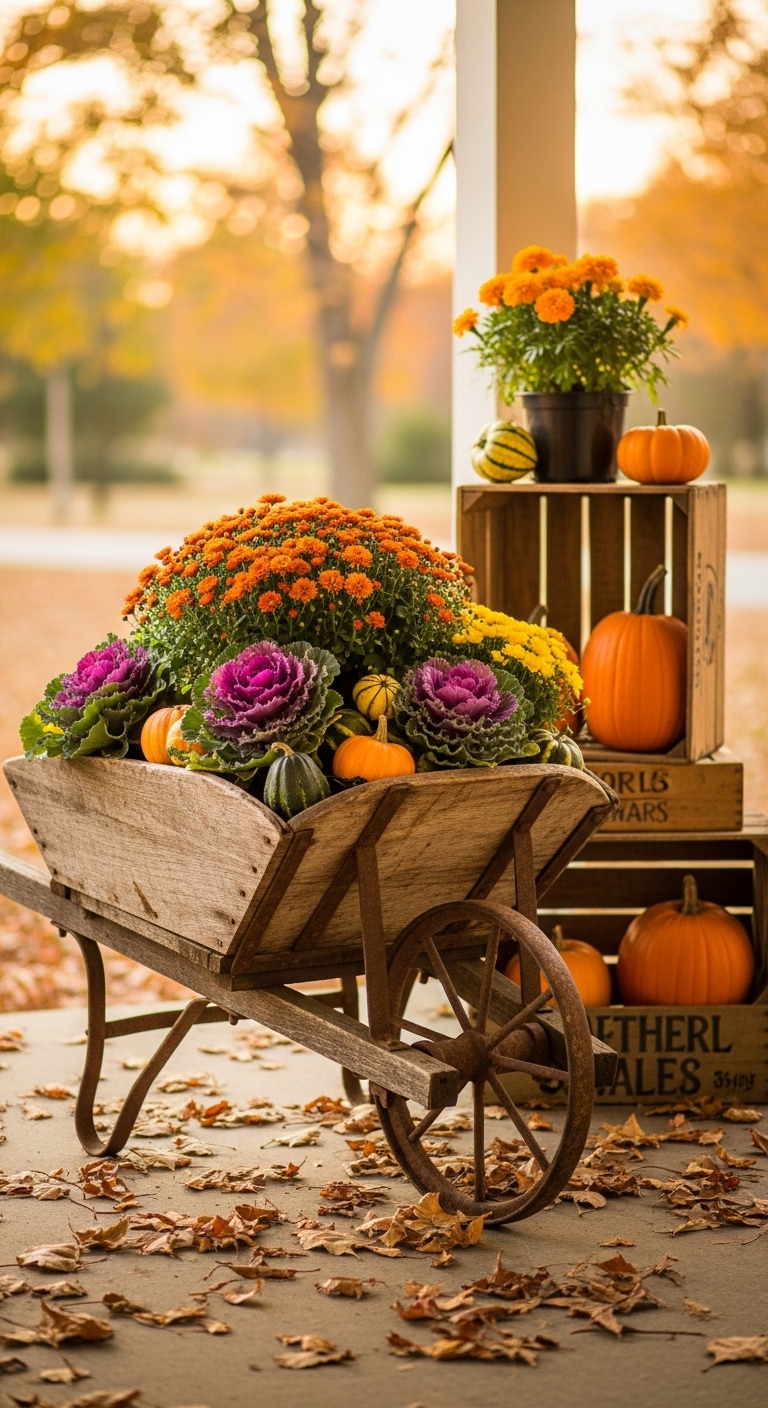
As summer fades, fall offers new opportunities for flea market garden displays. Vintage apple crates filled with mums, old wheelbarrows planted with ornamental kale and cabbage, or collections of antique harvest baskets create seasonal interest.
This is also the perfect time to create vignettes using natural elements like pumpkins, gourds, and dried cornstalks combined with your vintage pieces. That old harvest table becomes the perfect backdrop for a fall display that celebrates the season’s bounty.
Winter Structure
Even in dormant months, your flea market garden can provide visual interest. Evergreen arrangements in vintage containers, architectural pieces dusted with snow, or outdoor lighting highlighting special features can keep your garden beautiful year-round.
I leave many of my structural vintage pieces in place through winter, knowing they’ll look beautiful covered in snow or frost. An old iron gate or bench becomes sculptural when outlined in winter white, creating a completely different kind of beauty than in the growing season.
Finding Your Flea Market Garden Inspiration
Sometimes, even the most enthusiastic gardeners need a little inspiration. Here are some ways to keep your creative juices flowing.
Garden Tours and Open Days
Many communities now feature garden tours that include flea market gardens. Seeing how others have incorporated vintage pieces into their landscapes can spark new ideas for your own space. Don’t be afraid to ask questions—most gardeners love to share their stories and sources.
Online Communities
Social media platforms like Instagram and Pinterest are treasure troves of flea market garden inspiration. Following hashtags like #fleamarketgarden or #vintagegardening can connect you with like-minded enthusiasts from around the world.
I’ve learned so much from online communities, from specific techniques for preserving vintage pieces to creative planting combinations I never would have considered on my own.
Books and Magazines
While online resources are wonderful, don’t overlook traditional print media. Garden books and magazines often feature professionally photographed flea market gardens that can provide inspiration and practical advice.
One of my favorite resources is a collection of vintage gardening books I’ve accumulated from flea markets themselves. Not only do they contain timeless advice, but they also serve as decorative elements in my garden shed!
Starting Your Flea Market Garden Journey
Feeling inspired but overwhelmed? Don’t worry—we’ve all been there. The key to successful flea market gardening is starting small and building gradually.
Begin with One Piece
Choose one special vintage item to serve as your starting point. It might be something you already own or a specific piece you set out to find. Let this item guide your initial efforts, building around it rather than trying to transform everything at once.
My first flea market garden project was simply an old wooden crate I filled with herbs. From that humble beginning grew an entire garden approach that has brought me so much joy over the years.
Create a Vision Board
Before you start shopping, create a vision board of flea market garden ideas that appeal to you. This can be a physical corkboard or a digital collection. Having a visual reference helps you stay focused when you’re faced with the overwhelming options at a flea market.
Set a Budget
It’s easy to get carried away when you’re surrounded by treasures. Set a realistic budget before you go shopping, and remember that some of the best flea market garden finds are the most affordable.
I keep a “garden fund” jar where I deposit spare change throughout the year. When I’m ready to go flea marketing, I take the cash with me. When it’s gone, it’s gone—no exceptions. This keeps impulse purchases in check while still allowing for the thrill of the hunt.
Embrace the Process
Here’s the thing about flea market gardening: it’s never really finished. Your garden will evolve as you find new treasures, as plants grow and change, and as your own tastes develop. And that’s not a bug—it’s a feature!
Some of my favorite garden elements came from happy accidents or experiments that didn’t turn out as planned but led to something better. The joy is in the process, not just the end result.
The Heart of Flea Market Gardening
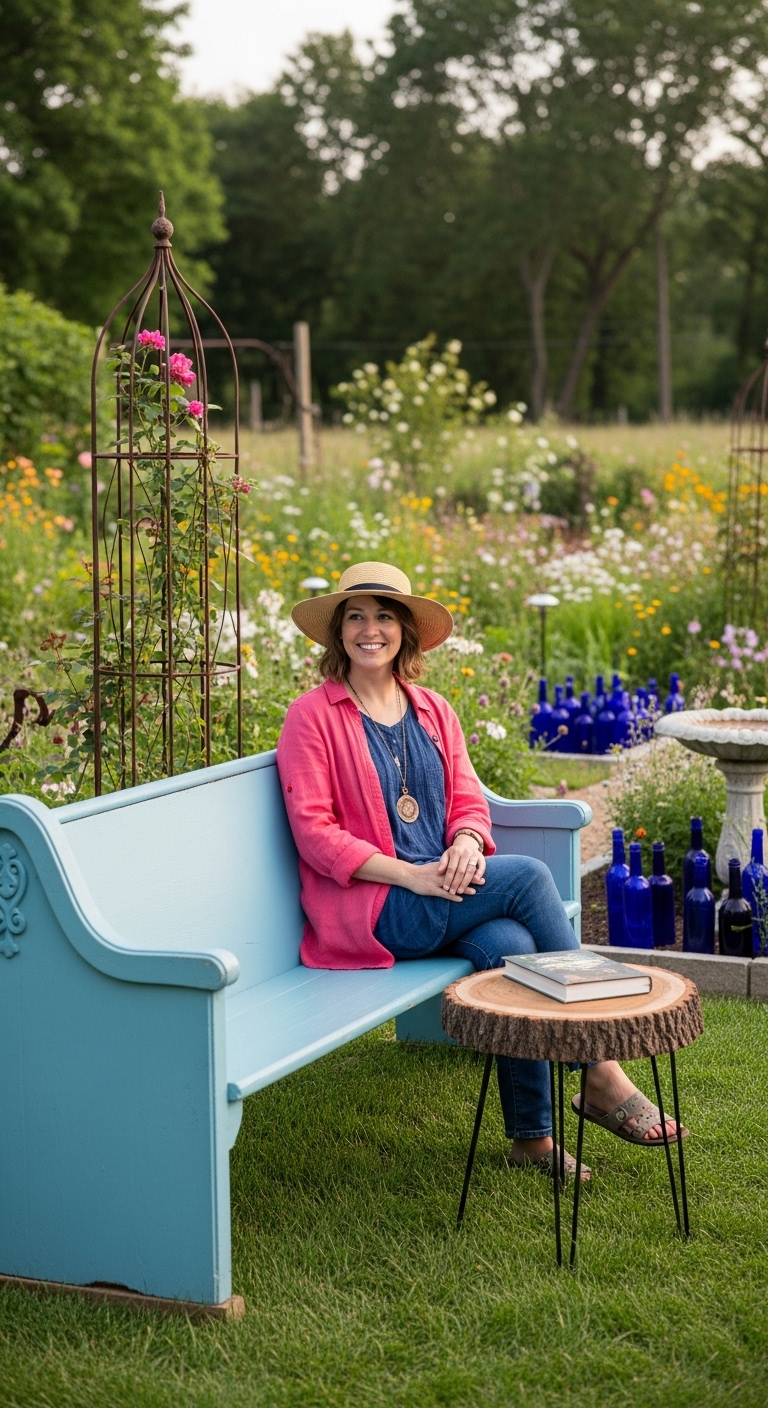
At its core, flea market gardening is about more than just decorating with old stuff. It’s about sustainability, creativity, and storytelling. It’s about seeing potential where others see discard. It’s about creating spaces that reflect our values and our histories.
When you place a vintage find in your garden, you’re not just adding an object—you’re adding a story. That rusted watering can might have watered victory gardens during World War II. Those chipped enamel bowls might have held a family’s meals for generations. By giving these items new life in your garden, you become part of their continuing story.
And isn’t that what gardening is all about? Connecting with the past while creating something for the future. Nurturing growth while celebrating history. Finding beauty in imperfection.
So the next time you’re at a flea market and you spot something that speaks to you, don’t hesitate. Bring it home. Find its place in your garden. And join the wonderful world of flea market gardening, where every treasure has a tale to tell, and every garden tells a story.
Your flea market garden is waiting to be born. Happy hunting!
